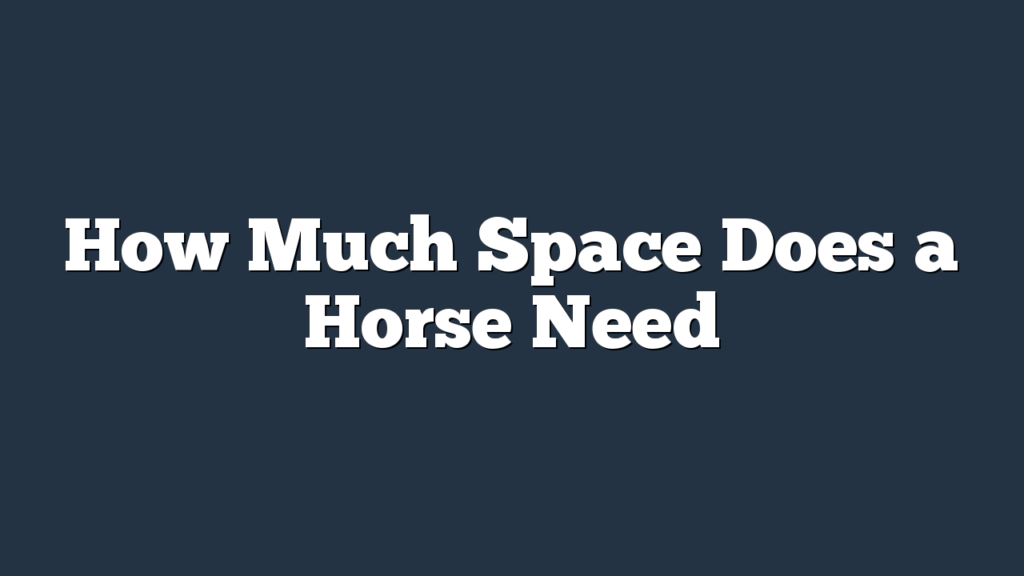Do you want to know how much space your horse needs to thrive? This article has got you covered! We will explore the various factors that influence horse space requirements, from minimum space needed to ideal grazing and exercise areas.
Whether your horse is stabled or enjoys the great outdoors, we will provide recommendations for different horse breeds.
Plus, we’ll share some tips to maximize space efficiency for your equine companion.
Let’s dive in!
Factors Influencing Horse Space Requirements
To determine the appropriate amount of space for a horse, it’s important to consider various factors that influence their space requirements.
Two key factors to consider are fencing options and pasture management. When it comes to fencing options, it’s crucial to choose a sturdy and secure fencing system that can contain the horse safely. Traditional options such as wooden or vinyl fences are popular choices due to their durability and aesthetics. Electric fences can also be an effective option, as long as they’re properly maintained and the horse is trained to respect the boundaries.
Another important factor to consider is pasture management. Horses need access to adequate grazing areas to meet their nutritional needs, so it’s essential to ensure that the pasture is well-maintained and free from toxic plants. Regular rotation and rest of the pasture can help prevent overgrazing and maintain optimal forage quality.
Additionally, providing shelter, shade, and access to clean water are essential for the horse’s overall well-being.
Minimum Space Requirements for Horses
When considering the minimum space requirements for horses, there are three main points to consider:
- Adequate grazing area: Horses need enough space to graze and move freely.
- Shelter and turnout options: Horses need access to shelter to protect them from the elements. Providing ample turnout options is also crucial.
- Exercise and socialization: Providing opportunities for exercise and socialization are crucial for their physical and mental well-being.
Adequate Grazing Area
Ensure your horse has enough grazing area to meet its minimum space requirements. Factors such as the horse’s size, age, and activity level can affect its grazing behavior. Providing adequate grazing area allows the horse to exhibit natural grazing behaviors, which are important for its physical and mental well-being. One effective method is rotational grazing, which involves dividing the grazing area into smaller sections and rotating the horse between them. This allows the grass to regrow in the previously grazed areas, ensuring a constant supply of fresh, nutritious forage. Rotational grazing also helps prevent overgrazing and soil erosion. To better understand the minimum space requirements for horses, refer to the table below:
| Horse Size | Minimum Space Requirement |
|---|---|
| Pony | 0.5-1 acre |
| Horse | 1-2 acres |
| Draft Horse | 2-3 acres |
Providing enough grazing area is vital for your horse’s overall health and happiness.
Shelter and Turnout Options
For your horse to have adequate shelter and turnout options, it’s important to provide a space that meets its minimum requirements. When it comes to shelter design, your horse needs a sturdy and well-ventilated structure that can protect it from the elements. A three-sided shelter with a roof is typically sufficient, but make sure it’s large enough for your horse to comfortably turn around and lie down.
Additionally, consider implementing a paddock rotation system. This involves dividing the turnout area into smaller sections and rotating your horse between them. Paddock rotation helps prevent overgrazing and allows the grass to regenerate, ensuring a constant food source for your horse.
Exercise and Socialization
To provide your horse with the necessary exercise and socialization, it’s crucial to allocate sufficient space in their turnout area. Horses are social animals and need regular interaction with other horses to maintain their mental and emotional well-being.
A larger turnout area allows for more opportunities for socialization, as horses can move freely and interact with their companions. Additionally, having enough space enables horses to engage in natural behaviors such as running, playing, and grazing. This promotes physical fitness and helps prevent boredom and behavioral issues.
When designing your horse’s turnout area, consider providing various exercise options, such as hills or obstacles, to keep them mentally stimulated and physically challenged.
Ideal Space for Grazing and Exercise
Now let’s talk about the ideal space for your horse’s grazing and exercise needs.
To ensure optimal grazing, you’ll want to consider the acreage available for your horse to roam and feed.
Additionally, it’s important to discuss the exercise area requirements to promote the well-being and physical fitness of your horse.
Optimal Grazing Acreage
You should provide a minimum of two acres of grazing acreage for a horse to ensure optimal space for grazing and exercise. This optimal pasture size allows the horse to have enough room to move around and engage in natural behaviors, such as grazing and playing.
Additionally, providing enough space helps prevent the horse from becoming bored or frustrated, leading to better mental and physical health.
To further enhance the horse’s grazing experience, implementing a pasture rotation system is recommended. This involves dividing the grazing area into smaller sections and periodically rotating the horse’s access to different sections.
This practice helps maintain the quality of the pasture, prevents overgrazing, and allows for the natural regrowth of grass, providing the horse with a continuous supply of fresh and nutritious forage.
Exercise Area Requirements
Provide your horse with a spacious exercise area to ensure optimal space for grazing and exercise. Outdoor space is crucial for horses as it allows them to engage in natural behaviors, maintain their physical and mental well-being, and fulfill their exercise needs. Several factors affect a horse’s exercise requirements, including breed, age, and health condition. The importance of outdoor space cannot be overstated, as it encourages horses to move freely, socialize with other horses, and exhibit natural behaviors such as grazing and playing. To give you an idea of the ideal exercise area for your horse, consider the following table:
| Size of Horse | Minimum Exercise Area |
|---|---|
| Pony | 0.5 – 1 acre |
| Horse | 1 – 2 acres |
| Draft Horse | 2 – 3 acres |
Considerations for Stabled Horses
Stabled horses require adequate space for their comfort and well-being. When considering the needs of stabled horses, it’s important to take into account various factors that can influence their behavior and affect their health. Here are some key considerations:
- Space for movement: Horses need room to move around freely in their stalls. A cramped space can lead to boredom, stress, and even physical injuries. Providing enough space for the horse to walk, turn around, and lie down comfortably is essential.
- Social interaction: Horses are social animals and need opportunities to interact with other horses. If possible, stables should be designed to allow visual and physical contact between neighboring horses. This can help reduce stress and prevent the development of undesirable behaviors.
- Environmental stimulation: Horses are naturally curious creatures and need mental stimulation to thrive. Providing environmental enrichment, such as toys, hanging treats, or even a window to look out of, can help prevent boredom and improve their overall well-being.
Considering these factors when stabling horses can greatly contribute to their happiness and health. By providing adequate space, social interaction, and environmental stimulation, you can create a more comfortable and enriching environment for your stabled horses.
Space Recommendations for Different Horse Breeds
Considering the needs of stabled horses, it’s important to take into account the space recommendations for different horse breeds. Factors affecting space requirements include the size, activity level, and temperament of the horse. For example, larger breeds such as Clydesdales and Shires require more space to move around comfortably compared to smaller breeds like Shetland ponies. Additionally, horses that are more active and energetic will benefit from larger spaces to prevent boredom and encourage natural movement.
The importance of turnout can’t be overstated when discussing space recommendations for different horse breeds. Turnout refers to the time horses spend outside of their stalls in a pasture or paddock. It allows them to socialize, graze, and engage in natural behaviors like rolling and running. Turnout is crucial for the mental and physical well-being of horses and can greatly reduce the risk of health issues such as obesity and digestive problems.
When determining the appropriate space for a horse, it’s essential to consider both their size and their need for turnout. Providing enough space and turnout for your horse’s breed and individual needs will help ensure their overall health and happiness.
Tips for Maximizing Space Efficiency for Horses
To optimize space efficiency for your horse, focus on organizing their belongings and utilizing storage solutions. By implementing these tips, you can make the most of the available space and provide a comfortable environment for your equine companion.
- Maximizing Pasture: Utilize your horse’s pasture effectively by dividing it into smaller paddocks using electric fencing or safe, sturdy panels. This allows for rotational grazing, where horses are moved between paddocks to prevent overgrazing and maintain healthy pastures. Rotational grazing not only maximizes the use of available space but also promotes the natural grazing behavior of horses.
- Efficient Feeding Stations: Set up feeding stations strategically to minimize waste and maximize space. Use feeders that are designed to minimize spillage and keep hay off the ground. This not only reduces feed waste but also helps maintain a clean and organized feeding area.
- Smart Storage Solutions: Invest in storage solutions that keep your horse’s belongings organized and easily accessible. Use tack trunks or wall-mounted racks to store saddles, bridles, and other equipment. Keep grooming supplies in labeled bins or hanging organizers. This not only saves space but also makes it easier to find and care for your horse’s belongings.
Frequently Asked Questions
Can Horses Be Kept in Small Spaces Such as a Backyard or Urban Area?
You’ll face backyard limitations and urban challenges when keeping horses in small spaces. It’s important to consider their need for exercise, grazing, and social interaction, which may be difficult to provide in cramped environments.
What Are the Potential Negative Consequences of Inadequate Space for Horses?
Not giving horses enough space can lead to negative consequences and health issues. Inadequate space can cause stress, lack of exercise, and increased risk of injuries. It’s important to provide enough room for a horse’s well-being.
How Does the Age and Size of a Horse Affect Its Space Requirements?
Age and exercise play a significant role in determining a horse’s space requirements. The impact of size should also be considered. Adequate space is crucial for a horse’s physical and mental well-being.
Are There Any Alternatives to Providing Large Grazing Areas for Horses?
There are alternatives to large grazing areas for horses. You can consider confinement options such as a stable or a paddock with limited space. These options provide a controlled environment for the horse’s needs.
What Are the Potential Benefits of Providing Ample Space for Horses, Besides Their Physical Well-Being?
Providing ample space for horses has numerous benefits. It promotes socialization, allowing them to interact and form bonds with other horses. This contributes to their psychological well-being, making them happier and healthier overall.
Conclusion
In conclusion, providing adequate space for horses is essential for their well-being and happiness. Factors such as breed, stabling, and grazing needs should be considered when determining the minimum space requirements.
By maximizing space efficiency and ensuring horses have room to move and exercise, you can contribute to their overall health and quality of life.
Remember, a happy and content horse is a horse with enough space to roam and thrive.



